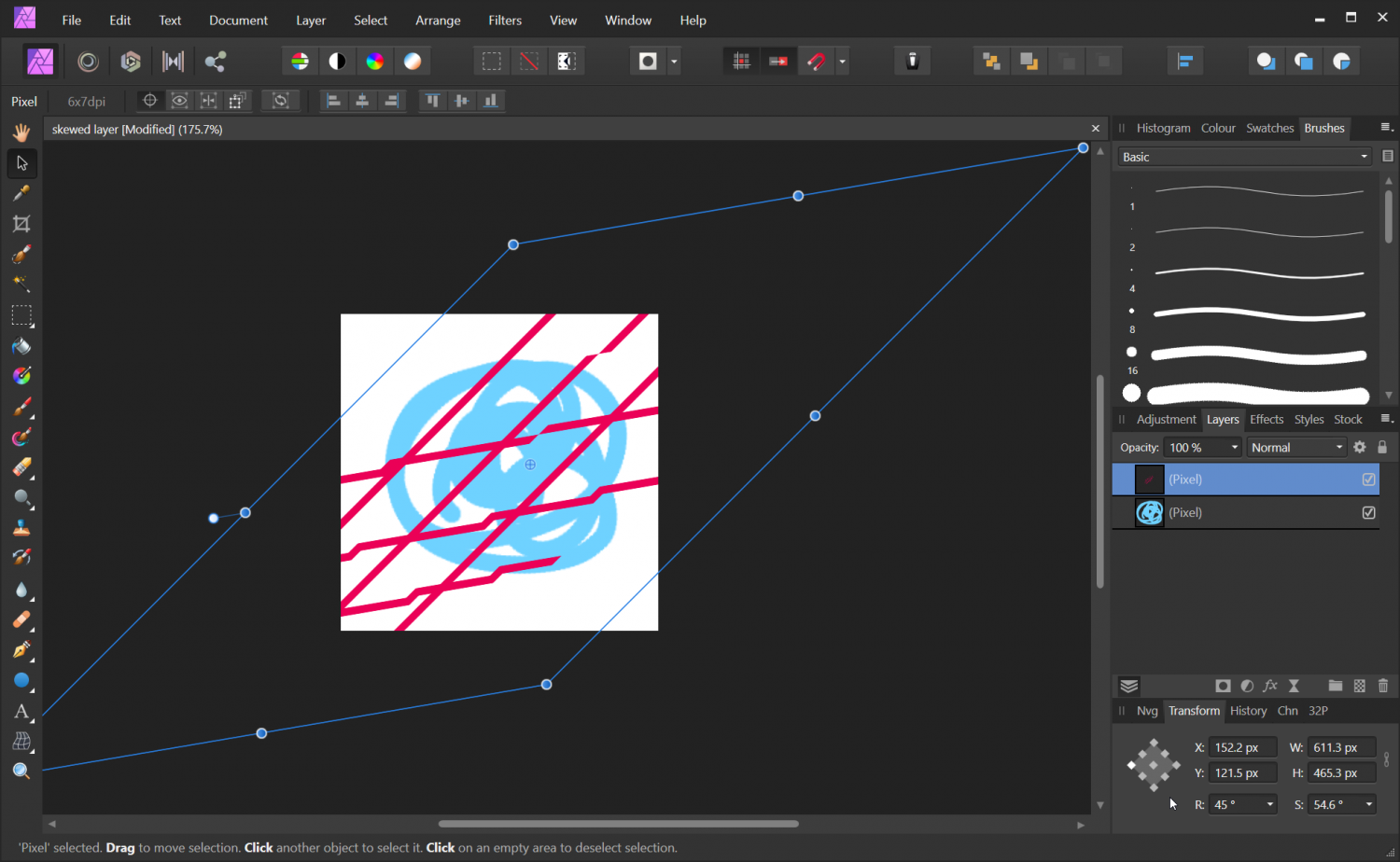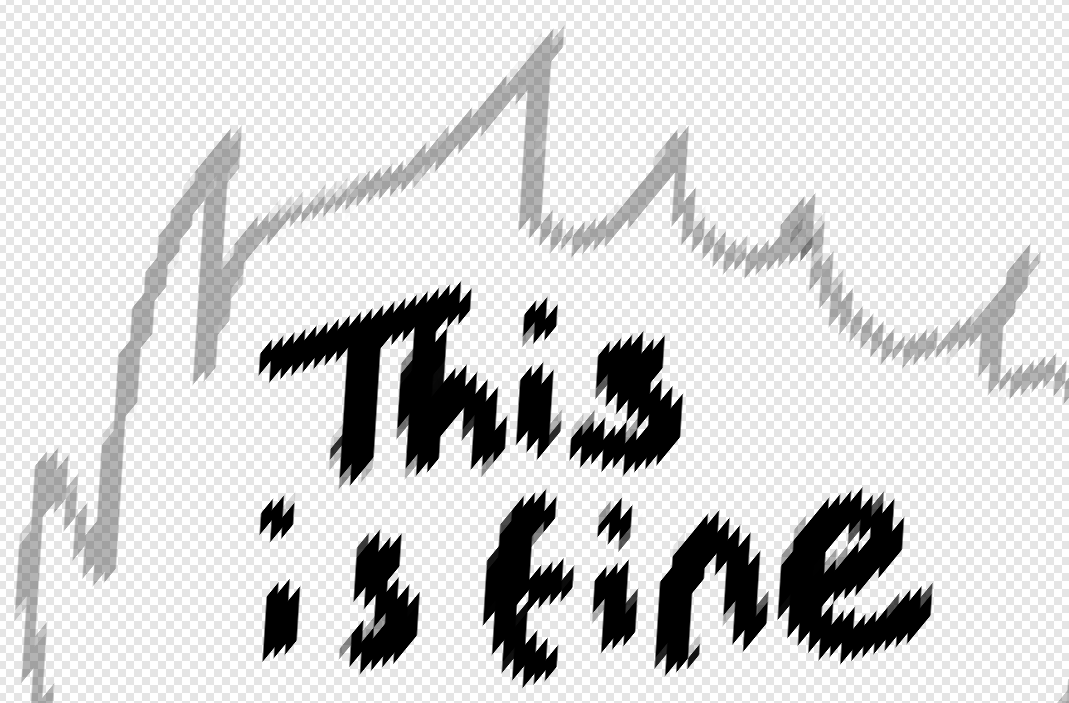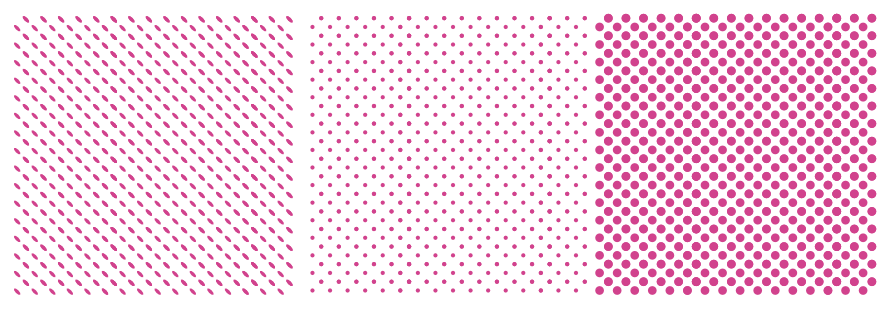-
Posts
19 -
Joined
-
Last visited
Posts posted by dock
-
-
Came here looking for this feature. It's frustrating every day.
It's especially annoying because I have to manually turn off my dark background layer when exporting via slices. -
@Old BruceThanks for trying to help. Looks like scaled pixel layers are pretty janky. Shame.
The lines were drawn on a skewed layer as a test. I want to be able to create pixel layers in Affinity Photo and scale them non-destructively to preserve the resolution. Trying to scale it down manually to what it was originally doesn't appear to work either, even when the resolution is known. Pretty frustrating.So in order to make non-destructive lower resolution layers I need to create a separate document for each one, and load/edit each document separately? yikes.

-
Thank you @Old Bruce!!
I was able to find the shear and rotation values in the Transform panel, but I can't find the Context Toolbar values -
One of the things I like about Affinity Photo is that different layers can have different PPI resolutions.
Unfortunately it appears to be impossible to see the resolution, or access the raw image data per layer.Is it possible to reset the transform on a layer? I don't mean 'Rasterizing', which is a destructive conversion to a different format.
I would also love to be able to export layers at their native resolution.
Here's an example of a low resolution skewed layer. I would love to be able to access these pixels and export the unskewed version. Any suggestions?

-
I have the slices rename freezing problem on a powerful new machine with 32GB RAM.
The file is only 388kb and has 5 slices, and the application freezes for 10+ mins.
-
I tried hand drawing in Affinity for a while but the lack of Vector eraser was a huge blocker for me. I doubt it'll be in Affinity Designer before 2025.
All of my hand drawn stuff is now drawn in GoodNotes on iPad, or OneNote on Windows/iPad. With Onenote I end up having to use 'print to PDF' to export the drawings as vectors. It's a nasty workaround, but at least it's an option. I wish I didn't have to work this way, but the 'eraser' solution in Affinity Designer is terrible.
-
I just started using Designer on iPad and I am sorely missing any type of tiling pattern support.
-
I just tried every workaround for adding my palette to Designer on iPad to no avail.
I added the palette as a document palette on the PC, then opened the file on the iPad. The palette exists, but can’t be added as an Application palette.
Also, I started a custom Application palette but it didn’t sync when I closed the software. I can’t believe how terrible palette support is. A great shame!
-
-
I'm really enjoying the Export Persona for flexible exporting in a variety for formats, but some basic UX has soured my experience quite a bit for the last couple of years.
My project involves a number of different Affinity Designer files with a variety of Export Slices. I've been pleased with the tools, but I find the UX for exporting slices pretty annoying every day.
- Move mouse to top left to switch to the Export Persona
- Move mouse to the right, find the Slices Tab
- Move mouse to the bottom right to the Export Slices
- Click past the 'overwrite files' warning
- Mouse top left - back to Designer PersonaAll of this could be a keyboard shortcut. The 'continuous export' causes a bunch of problems too, and I think it disables between sessions.
The File>Export option isn't helpful either, as it seems to pretend the Slices and Export Persona don't exist.
It's very rare that I'd praise Blender's UX over Affinity's, but its ability to right click any button and assign a keyboard shortcut makes a huge difference for clumsy UX for repeated tasks.If you ever add a shortcut setting, or add the Export Slices as something you can add to the menus, it would be an amazing help for those of us that rely on it.
-
Thanks for the advice, everyone! I see that it's a matter of juggling different techniques to get the result I want. It's disappointing to think we might never see embedded patterns but I'm glad to see the other methods employed here.
@reglico I've used the 'many dots' approach in the past, but it always felt really clumsy, especially if I wanted to make any changes or make an alternative. I guess that's what I need to use, nevertheless!The workaround I've ended up with relies on a combination of Affinity's Assets for easily placed objects and Inkscapes 'Transform Each' for modifications. I may end up using Inkscape's tiling pattern too, because the Ctrl+J cloning can be clumsy. The middle example is a pattern I made in affinity, and the left and right are transformations of this pattern thanks to Inkscape.
Using Assets seems to help a lot, although it's a shame there's no easy way to update those.
-
1 hour ago, reglico said:
Hello Dock,
I don't know if this is right for you, but you can create a vector pattern and insert it inside the shape, it will simply be clipped. This allows its subsequent modification independently of the shape itself. Instead of putting the pattern in styles you can put it in assets so that it is always available.
I was intending to do polka dot style patterns... should I really create hundreds of circles? I know about the trick of using symbols for pattern clusters, but this is clumsy too.
What do do you mean regarding putting the pattern into assets?
-
The project I'm working on will need to use 'tiling patterns' for some of the graphics.
Currently the only option for patterns in Affinity Designer is to use the Fill tool to import a Bitmap. This may be saved as a style.
The bitmap will not and cannot be updated, and the size and tiling will scale relative to the object, rather than the document.Working with patterns this way is so terrible that it's definitely not fit for the task, so Affinity Designer is starting to really drag down the project.
Does it seem likely we will see any sort of patterned area fill in the next six months, or should I abandon Affinity Designer for now and go for Illustrator?
-
The fact that this bug has been reported for more than a year with no budge makes me worry even more.
The problem is less about the drive but the fact that Affinity closes/kills the document!! It makes no sense. If a disk is full will it kill my document? If my disk access is slow will Affinity time out and delete my work? The idea that the software is happy to destroy work done is absurd.
I appreciate that cloud services might make saving non-trivial, but it really should be reasonable that I can choose save without losing my work.
-
Twice in the last few months I have pressed Ctrl S only for Affinity Designer to nuke my work.
I would save my work and Affinity has given an error before shutting down completely. It is by far the worst time to ditch someone's work, and makes me wonder whether I should be screenshotting (!) my work before saving, just in case.I was told via Twitter that this has something to do with using external drives. I'm actually saving to Pcloud, which is a cached local drive. I've never seen another application act like this.
I encountered this first in September, and again one week ago.
-
Oh no, it's not coming for a while? I just spent far too long struggling to find this feature. Wow.
There are so many complex and strange alignment options, but the only one I use every day is missing in Affinity.What do people suggest as a workaround? Is there an accurate way to position with snapping or similar?
-
I really like the ability to offset the stroke to the inside, outside or centre of the stroke.
Unfortunately, I noticed that it only works on closed strokes! I understand that a single stroke doesn't have a concept of inside and outside, but the functionality is still very useful.
Even if it misunderstood which was the inside and outside, and even if that got flipped when I closed the loop, it would still be very useful.
-
Would it be possible to allow some of my export slices to ignore certain layers, but others to include them?
I'm often working on multi-layered images for use in games, and every time I export i have to turn off specific layers beforehand.
I appreciate the current option to set layers to not be exported, but I'd prefer some more power to limit certain layers to certain slices, so I can export the foreground, middle and foreground objects cleanly.











Affinity Designer: Allow export slices to ignore certain layers.
in Older Feedback & Suggestion Posts
Posted
It's 2024 and this still doesn't work any better.
Unfortunately there's no option of a dark background grid either, so I have to turn on and off the background layer constantly.